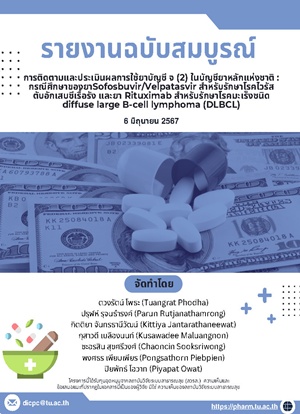บทคัดย่อ
ที่มา ยาจำเป็นในบัญชี จ(2) ของบัญชียาหลักแห่งชาติเป็นยาที่มีราคาแพง ระบบประกันสุขภาพภาครัฐทั้ง 3 ระบบหลัก มีแนวทางการบริหารจัดการเกี่ยวกับยาที่แตกต่างกัน ตั้งแต่การกำหนดกรอบสิทธิประโยชน์ด้านยา การจัดยาและการกระจายยาสู่หน่วยบริการ และการควบคุมและส่งเสริมการใช้ยาสมเหตุผลนั้น ได้ส่งผลต่อการเข้าถึงยาและค่าใช้จ่ายด้านยา จำเป็นต้องมีการพัฒนางานติดตามและประเมินผลการใช้ยา (monitoring and evaluation) การศึกษานี้มีวัตถุประสงค์เพื่อศึกษาการพัฒนางานด้านระบบติดตามและประเมินผล บัญชียาหลักแห่งชาติ กรณีบัญชี จ(2) ในระดับประเทศ โดยใช้กรณีศึกษายา Sofosbuvir/Velpatasvir ซึ่งเป็นยาที่มีปริมาณการใช้สูงมาก และยา Rituximab ซึ่งมีผลกระทบงบประมาณสูง ระเบียบวิธีวิจัย การวิจัยแบบผสมวิธี (mixed methods) ประกอบด้วยการศึกษาเชิงปริมาณ (quantitative study) โดยเก็บข้อมูลปริมาณและมูลค่าของการสั่งใช้ยา รวมถึงการประเมินและรายงานผลลัพธ์ทางคลินิกในผู้ป่วยที่ได้รับยา Sofosbuvir/Velpatasvir และยา Rituximab ในโรงพยาบาลระดับตติยภูมิ ในสังกัดสำนักงานปลัดกระทรวง กระทรวงสาธารณสุข และโรงพยาบาลโรงเรียนแพทย์ แบบภาคตัดขวาง (cross-sectional study) ในปีงบประมาณ 2564 (1 ต.ค. 2563 ถึง 30 ก.ย. 2564) และการศึกษาเชิงคุณภาพ (qualitative study) โดยการสัมภาษณ์เชิงลึก (in-depth interview) กลุ่มตัวอย่างบุคลากรทางการแพทย์ที่เกี่ยวข้อง เพื่อศึกษาการสั่งใช้ยา Sofosbuvir/Velpatasvir และยา Rituximab และกลุ่มตัวอย่างผู้ป่วย/หรือญาติ เพื่อศึกษาการได้รับยาของผู้ป่วย ผลการศึกษา ภาพรวมพบว่าการสั่งใช้ยา Sofosbuvir/Velpatasvir ตามเกณฑ์การใช้ยาที่กำหนดในบัญชี จ(2) คิดเป็นประมาณร้อยละ 55 ในขณะที่การสั่งใช้ยา Rituximab ตามเกณฑ์คิดเป็นประมาณร้อยละ 84 มูลค่ายา Sofosbuvir/Velpatasvir ต่อผู้ป่วย 1 ราย มีค่าเฉลี่ยอยู่ระหว่าง 20,217.03 – 27,945.90 บาท และมูลค่ายาต่อครั้ง มีค่าเฉลี่ยอยู่ระหว่าง 9,048.18 – 12,917.22 บาท ในขณะที่มูลค่ายา Rituximab ต่อผู้ป่วย 1 ราย มีค่าเฉลี่ยอยู่ระหว่าง 67,468.80 – 121,050.22 บาท และมูลค่ายาต่อครั้งมีค่าเฉลี่ยอยู่ระหว่าง 13,015.05 – 25,156.09 บาท สรุป งานติดตามและประมินผลสำหรับการใช้ยาบัญชี จ(2) ในบัญชียาหลักแห่งชาติ ในส่วนของการประเมินการสั่งใช้ยาตามเกณฑ์การใช้ยาที่กำหนดในบัญชี จ(2) การประเมินความสม่ำเสมอในการได้รับยาของผู้ป่วยตามแผนการรักษา การประเมินความครบถ้วนของการติดตามผลการรักษาภายหลังจากที่ผู้ป่วยได้รับยา รวมถึงมูลค่าการใช้ยา สามารถคำนวณได้จากข้อมูลที่มีอยู่ในฐานข้อมูลของโรงพยาบาล อย่างไรก็ตามควรมีการพัฒนาความเชื่อมโยงของฐานข้อมูลโรงพยาบาลและกองทุน เพื่อให้สามารถวิเคราะห์ข้อมูลการเข้าถึงยาได้อย่างมีประสิทธิภาพต่อไป
บทคัดย่อ
Background Essential medicine category E(2) in the National List of Essential Medicine (NLEM) is
high price medicine. Three health insurance schemes have different drug management systems,
pharmaceutical benefits schemes, drug procurement, drug distribution to hospitals, and rational
drug use control that impact drug access and expenditure. Monitoring and evaluation (M&E) are
needed to be developed. This study aims to study the development of M&E for using essential
medicine category E(2) in NLEM at the national level, a case study of Sofosbuvir /Velpatasvir with
extreme amounts and Rituximab with high budget impact.
Methods A mixed methods design was employed in this study. A cross-sectional study gathered
the amount and value of drug utilization at four tertiary care hospitals under the Permanent
Secretary Ministry Office of Public Health and four university hospitals under Ministry of Higher
Education, Science, Research and Innovation in the fiscal year of 2021 (1st October 2020 – 30th
September 2021). In-depth interviews were conducted with related healthcare personnel to study
criteria for prescribing Sofosbuvir /Velpatasvir and Rituximab and patients or caregivers for studying
drug access.
Results The prescribing rate of Sofosbuvir/Velpatasvir, according to the criteria for essential
medicines category E(2) in the NLEM, was 55%. In contrast, Rituximab was prescribed at a higher
rate of 84%. The average values of Sofosbuvir/Velpatasvir per patient were ranged from 593.03
to 819.75 USD, with a per-visit between 265.41 and 378.91 USD. For Rituximab, the average values
per patient were ranged from 1,979.09 to 3,550.82 USD, with a per-visit between 381.77 and
737.91 USD. (34.0908 THB=1 USD on 30th September 2021*)
Conclusion Monitoring and evaluating essential medicines in category E(2) of the NLEM can be
effectively done using hospital databases. This includes assessing prescribing practices, patient
compliance with treatment plans, follow-up on clinical outcomes, and the financial value of drug
use. However, for a more comprehensive analysis of drug access, it is essential to link hospital
databases with healthcare insurance data.


